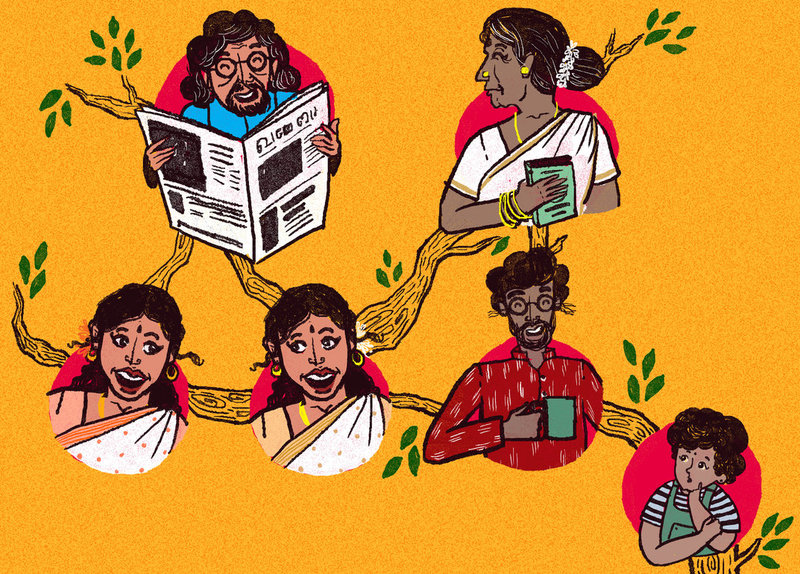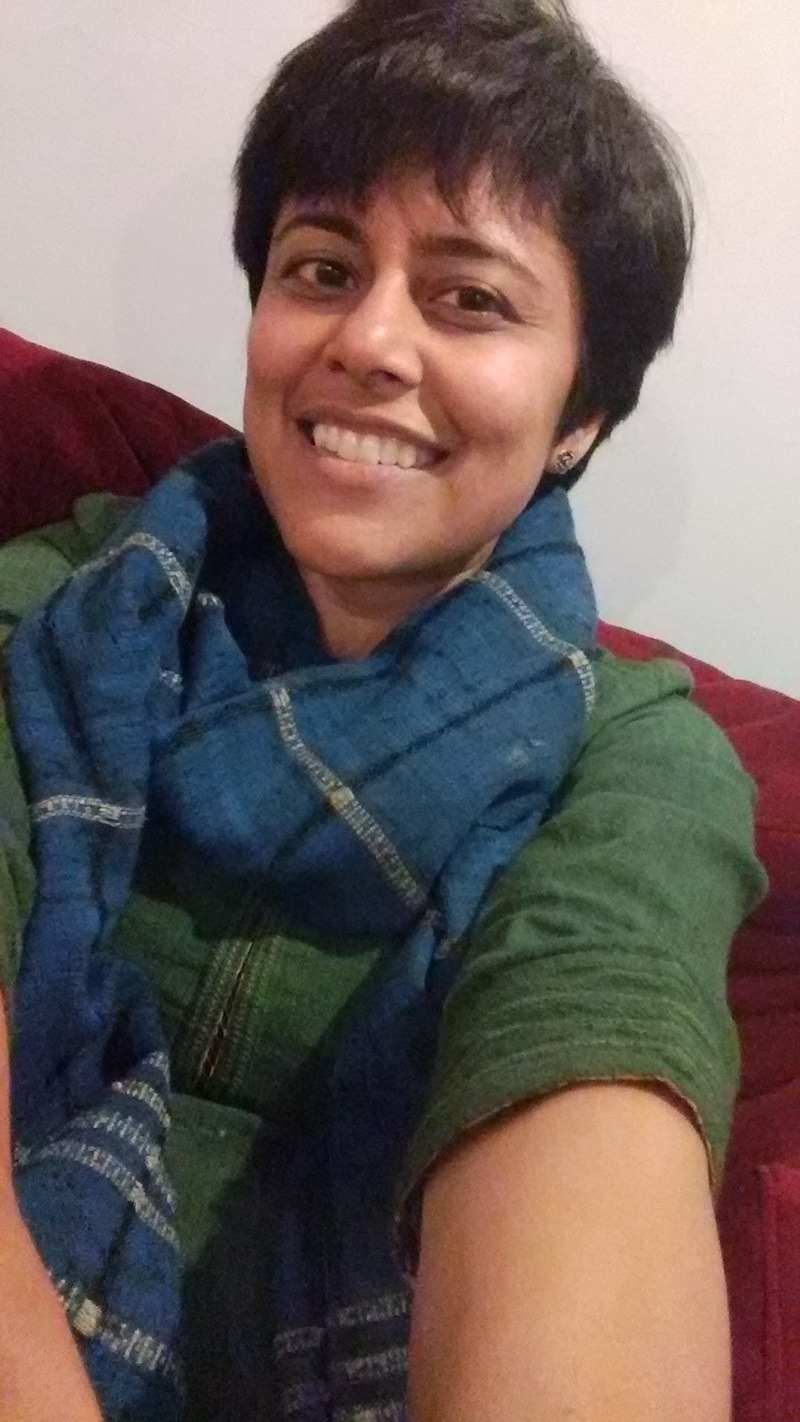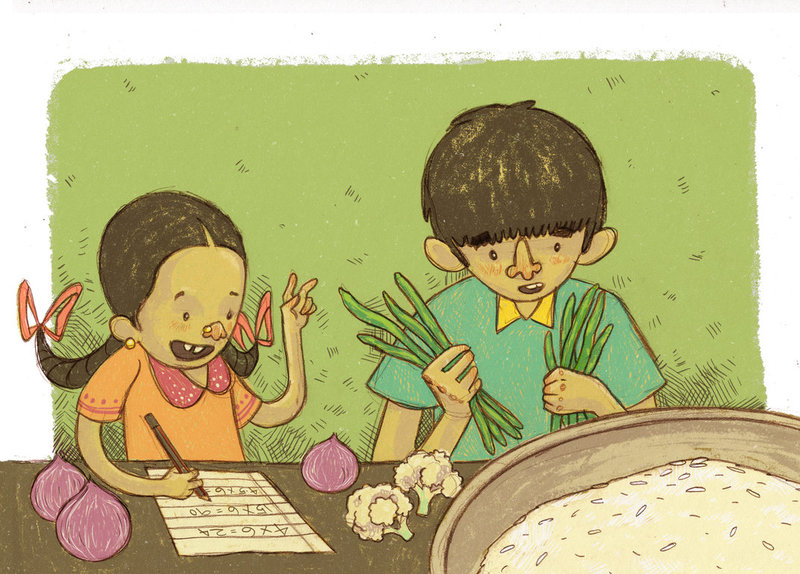Where do you come from?
Posted by Remya Padmadas on March 04, 2016
Langlen has curly hair like Appa and a cleft chin like Imma. It makes her wonder why brothers and sisters, or parents and children look alike. Is she just a collection of traits, then? So many questions, but Imma and Appa have all the answers. 'Where Did Your Dimples Go?' is a lovely book to introduce children to the concept of genetics and heredity.

Activities
Make Your Own Family Tree
(Source: Pinterest)
Ask the children to bring photos of their family members - siblings, parents, grandparents… may be even their pet dog!
Resources
-
Printouts of family tree template Click here for a template.
-
Glue stick
-
Colour pencils
What to do
-
Children can stick their family members in the family tree template and colour it in.
-
Afterward they can study each other’s tree and decide who they look like, or perhaps older children can discuss who they take after in their family.
What would happen if a..
Resources
-
Paper
-
Pencils
-
Colour pencils/sketch pens
What would happen if a monkey and a giraffe had a baby together? What traits would it inherit from both its parents? Draw the results - which we promise will be hysterical!
Be the first to comment.Recipe for Success! Fun activities with Dum Dum-a-Dum Biryani!
Posted by Remya Padmadas on March 01, 2016
Basha and Sainabi are in a panic. Ammi is ill, and Saira aunty has just announced that she is arriving for lunch - with 23 other people! Budding chef Basha thinks he can cook Ammi's Dum Biryani, but her recipe only makes enough for 4 people. Math wiz Sainabi jumps in to help, declaring that she knows how to turn a 4-person recipe to a 24-person recipe. Do the siblings succeed in serving up a truly Dum Dum-a-Dum biryani?

ACTIVITIES
Ball Toss!
Resources
A ball
How to play
-
Have the children stand around in a circle.
-
Toss the ball to the next child, or any child if you want to make it mad.
-
Say a food ingredient while tossing the ball (keep this open across languages, for eg: haldi will do).
-
Every time the ball is tossed the child who catches it has to say the name of an ingredient.
-
First child to repeat or blank is out.
Play till you get 3 winners.
Weave-A-Story
Resources
-
Paper
-
Pens
What to do
-
Put up a picture or a first sentence as a writing prompt.
-
Prompts: My pet kangaroo was hungry and all I had in the fridge was a pod of garlic….
-
More Prompts: We, my sister and I, were making our first ‘all-by-ourselves’ cake for my mother’s birthday. What started out as a special day soon turned bizarre…to say the least…
-
And more: Remember the summer break when we managed to catch the ‘milk stealing thief’ of our colony.
-
Divide the children into small groups and have them create the story from that prompt.
-
Each child takes a turn writing one sentence to add to the story and passes it on to the next.
-
Keep it going in the group until they have finished it (maybe helpful to have a length or a time limit so that the stories don’t go toooo out of control)
-
When all the groups have finished, ask a volunteer to come up and read the story out!
This isn't a spoon! it's a...
Materials needed: A bunch of kitchen utensils (10): ladle/spoon, pressure cooker whistle, lid of a pan, fork, wooden spatula, lemon squeezer
What to do
-
Divide the group into clusters of 5 kids each
-
Hand over 2 utensils to each group.
-
Give the teams 15 minutes of preparation time to devise a play and use the utensils as creative props; use them for creative purposes other than their regular use. Is it a ladle or a microphone?
-
Other Teams and you act as judges and award points to each other.
Team with the highest points wins!
Be the first to comment.
A Mathematical Journey
Posted by Remya Padmadas on March 01, 2016
Roopa Pai is a computer engineer who always knew she was going to write for children. She is the author of Taranauts, India's first fantasy-adventure series for children in English,and several others, including some for Pratham Books. Her latest bestseller is 'The Gita For Children'.
This is why I love my job. Every so often, a project comes along that holds out the tempting prospect of a never-before challenge. I take such projects on with (an admittedly nervous) alacrity, because a challenge helps to keeps things fresh - it forces one to shift gears, to look at things through someone else's eyes, to tap into hitherto unexplored veins of creativity. And when it has been met to the best of one's ability, a challenge leaves one with a sense of accomplishment, of life having been enriched in some small way.
It was precisely such a challenge that Pratham Books' Storyweaver initiative dropped into my lap a few months ago. We want to create wonderful new stories, they said, and we want to create them quick. We want to hear new voices, on a myriad subjects. We want to help children discover disparate worlds - math, the environment, artificial intelligence, good values - through stories that are fun, engaging, and lushly illustrated. And we want to share them all, translated into a dozen different languages, with the world.
And once it is all online, they said, their eyes shining, anyone, anywhere in the world will be able to read them, for free! What's more, anyone, anywhere, can download them, print them, distribute them, translate them into any language in the world, use pictures from different books to weave new stories, or weave together different story threads to spin out brand new tales. Wasn't it all terribly exciting? And would I please be part of it?
It most certainly was, I said. And of course I would!
And that's how I landed my first job as editor. 'Guest editor', more correctly, with the responsibility of finding new children's writers, and generating, through them, four stories involving maths. The stories could be fiction or non-fiction, but they would have to deal with mathematical themes. As a sop to a first-time editor, they graciously allowed that I could write one of the stories myself.
I tossed ideas around in my head - what themes existed in primary-school level maths? Numbers, distances, patterns, measurements, arithmetic... What stories could be woven around them? The Storyweaver team and I went back and forth for weeks, until we came up with a list of ideas that we all agreed held promise. Then I went out to look for my crack team of debutante writers.
I didn't have to look far. Over the past couple of decades, I have had the pleasure of interacting and working with a number of talented, accomplished people who also work with children, but not necessarily as writers. When I had sliced and diced that contacts list to find people with backgrounds in science and / or math, AND people who lived in Bangalore (this for no other reason than that editorial meetings could then involve lots of laughing and chai-drinking), three names emerged. Fortunately for me, they all agreed instantly to be collaborators on an adventure that was new for all of us.
And who were these three people?
There was Gayathri Tirthapura, who trained as an engineer at REC (now NIT) Surathkal, before going off to the US for a double masters (Masters in Science from Stanford, Masters in Education from Harvard) and 10 years in the telecom industry. Since she returned a few years ago, Gayathri has run Kutoohala, a children's activity centre, library and bookstore where she puts all her theories on what makes for a fun, enriching education into practice.
There was Sukanya Sinha, a PhD in Physics from the University of Maryland, who has held research positions in several scientific institutes not just in India but elsewhere and is now a Visiting Professor at the Indian Statistical Institute. But Sukanya is also as much at home with demystifying complex scientific concepts to children - she is part of the founding team of Curiouscity, an organisation that promotes creativity in science among young people.
And there was Shonali Chandy Chinniah, a marine biologist from Cornell who has taught undergrad courses at both American and Indian universities, apart from conducting educational tours at the New Jersey Aquarium and working with NGOs in India to promote science education among the less privileged. Shonali is also part of the founding team of Curiouscity.
Over the course of the next few weeks, at several delightful and wonderfully stimulating editorial meetings (given the formidable - and creative - brainpower I was dealing with, it could not have been any other way), we picked different ideas, toyed with them, wondered if they would work better as fiction or non-fiction, and drank plenty of chai. Then everyone went off to write their stories.

The results of that most enriching experience is - or will soon be - up there on Storyweaver for all of you to enjoy. Already up are Sukanya's awe-inspiring non-fiction story on distances - 'How Far is Far?', and Gayathri's heartwarming fiction story on math in cooking - 'Dum Dum-A-Dum Biryani'. Coming up soon are Shonali's enjoyable non-fiction story - The Fabulous Fibonaccis - on the endlessly fascinating number sequence called the Fibonacci (or Hemachandra) sequence, and my own fiction story based on history and arithmetic - How Old Is Muttajji?
How would I rate my editorial challenge on a scale of 1 to 10? I would go off the scale - it's all allowed in maths - and say 0. Because, like that old song goes, no matter how big the challenge, you can always get by with a little help from your friends.
Be the first to comment.